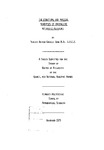THE STRUCTURAL AND PHYSICAL PROPERTIES OF CRYSTALLINE ANTIBIOTIC MATERIALS
| dc.contributor.author | GANE, PATRICK ARTHUR CHARLES | |
| dc.contributor.other | School of Engineering, Computing and Mathematics | en_US |
| dc.date.accessioned | 2013-10-07T09:34:41Z | |
| dc.date.available | 2013-10-07T09:34:41Z | |
| dc.date.issued | 1979 | |
| dc.identifier | NOT AVAILABLE | en_US |
| dc.identifier.uri | http://hdl.handle.net/10026.1/2046 | |
| dc.description.abstract |
Effectiveness in biological chemical environments virtually defines the term 'drug' when applied to any attempt to modify that environment by the introduction of an influence in terms of a specific compound or group of compounds. Interest in the configuration of the molecules involved in such modifications led to the X-ray structure determinations, discussed in the thesis, of the following three compounds: (i) 7-chloro-2-methyl-5-phenyl-3-propyl [2,3-b]-imidazolyl quinoline. Derived from the psychoactive drug Librium, it was thought to conform to the structure, containing the highly strained 4-membered monocyclic azete system (Shenoy, a thesis submitted for the degree of Doctor of Philosophy, University of London, 1975), and suggested as one of the first examples of possible stable 4-membered azacyclobutadiene rings. (ii) The methyl ester of 5,5-dimethyl-2-(2-phenoxymethyl-5-oxo-1,3-oxazolin-4-ylidene)-1,3-thiazolidine-4-carboxylic acid. | |
| dc.language.iso | en | en_US |
| dc.publisher | University of Plymouth | en_US |
| dc.title | THE STRUCTURAL AND PHYSICAL PROPERTIES OF CRYSTALLINE ANTIBIOTIC MATERIALS | en_US |
| dc.type | Thesis | |
| plymouth.version | Full version | en_US |
| dc.identifier.doi | http://dx.doi.org/10.24382/3828 | |
| dc.identifier.doi | http://dx.doi.org/10.24382/3828 |
Files in this item
This item appears in the following Collection(s)
-
01 Research Theses Main Collection
Research Theses Main


